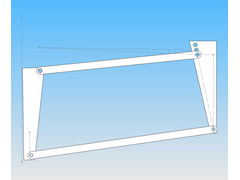So I guess that yes you probably should have your ride height and geometry all figured out long before you fit the coil over.
That's in an ideal world

[Edited on 26/5/07 by daviep]

ive been reading des hammil's book on sports car suspension, and it says that the front lower wishbone wants to be parallel to the floor, but i
cant see how you have control over that apart from the shock absorbers,
can anyone help clear this up for me
cheers, Theo
I don't quite understand your question?
If you are using coilover springs then all you do is wind the adjusters up.
sorry for being unclear, you have basically answered my question tho, i did mean coilovers, so what ur saying is what i was thinking,
the book says you want the lower wishbone parallel to the floor but make it sound as if this could be done before you even put the coilovers in
im still being unclear i know, but its hard to explain what i mean, im pretty sure what u said confirms what im thinking tho, so cheers
The wishbone mounting brackets must be mounted at the correct height on the chassis in order to achieve the correct ride height and the correct
geometry of the wishbones. Hope this makes sense, just trying to pont out that if your wishbones are not mounted at the right height then having the
lower bone level may end up with an unacceptable ride height.
So I guess that yes you probably should have your ride height and geometry all figured out long before you fit the coil over.
That's in an ideal world 
[Edited on 26/5/07 by daviep]
quote:
Originally posted by daviep
The wishbone mounting brackets must be mounted at the correct height on the chassis in order to achieve the correct ride height and the correct geometry of the wishbones. Hope this makes sense, just trying to pont out that if your wishbones are not mounted at the right height then having the lower bone level may end up with an unacceptable ride height.
So I guess that yes you probably should have your ride height and geometry all figured out long before you fit the coil over.
That's in an ideal world

quote:
Originally posted by theohighland
ive been reading des hammil's book on sports car suspension, and it says that the front lower wishbone wants to be parallel to the floor, but i cant see how you have control over that apart from the shock absorbers,
can anyone help clear this up for me
cheers, Theo
This is how mine will be on project X.
It gives positive and negative camber change depending in which direction it goes.
This ensures that the tyre contact patch stays on the road in corners.
Description


down
up
[Edited on 26/5/2007 by nitram38]
Also It's not quiet true that the wishbone should be parallel but the line between the inner pivots and the centre of the lower ball joint is the
one that counts.
This is only achievable, as Flak Monkey says, with proper planning and depends on ride height selected, wheel diameter, tyre profile, bracket location
and upright type. This is all part of the challenge (and fun) of building your own car  .
.
It is also only needed if it suits the roll centre height you want.
Yep,
And if you don't calculate good, you'll have to do it over, and over, and over
I'm doing it over. My inner pivots where at 220 mm. Now i'm back to the drawing table.
My bottom wishbone is not parrallel but about 13 mm point down-wards. :-)
(inner higher then outer)
The book of Hammil is quit good. But don't forget your static roll-centre!
Front about 4-6 cm above surface, rear about 8-12 cm. if your building a seven
BTW: Anybody know the rating upper/lower wishbone lenght?
Mine pivot/balljoint upper vs lower is about 0.79.
Anyone ????
I've seen a number of postings that suggest that the lower bones point downward by 1 deg to the outside at rest.
Suspension is a compromise, so what may work on one design may make another car handle badly. It also depends on what you are trying to use the car for.